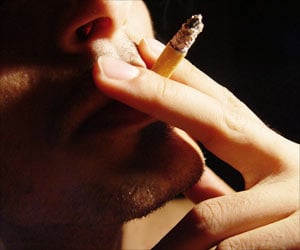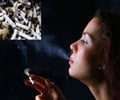
‘The useful technique maps sites on the genome that are undergoing repair following a common type of DNA damage caused by the major chemical carcinogen - benzo[α]pyrene.’
Tweet it Now
"This is a carcinogen that accounts for about 30 percent of the cancer deaths in the United States, and we now have a genome-wide map of the damage it causes," Sancar said.Maps like these will help scientists better understand how smoking-induced cancers originate, why some people are more vulnerable or resistant to cancers, and how these cancers might be prevented.
Sancar also hopes that providing such stark and specific evidence of smoking's harm at the cellular level might induce some smokers to kick the habit. There are about 40 million smokers in the United States and a billion worldwide.
"It would be good if this helps raise awareness of how harmful smoking can be," he said. "It also would be helpful to drug developers if we knew exactly how DNA damage is repaired throughout the entire genome."
BaP: Earth's Top Chemical Carcinogen?
Advertisement
Everyday forms of combustion, from forest fires to diesel engines and barbecue grills, put a lot of BaP into our air, soil, and food. But nothing in ordinary life delivers it into human tissue more efficiently than puffing on a lit cigarette.
Advertisement
BPDE reacts chemically with DNA, forming a very tight bond at the nucleobase guanine. This bond, or adduct, means that the genes can no longer make proper proteins and DNA can't be duplicated properly during cell division. And if that happens, disease can be the result.
"If a BPDE adduct occurs in a tumor suppressor gene and isn't repaired in a timely manner, it can lead to a permanent mutation that turns a cell cancerous," said Wentao Li, PhD, a postdoctoral researcher and lead author of the study.
There is no doubt about the basic carcinogenicity of chemical reaction. Paint a moderate dose of BaP on the skin of a lab mouse, and tumors are almost certain to erupt. BaP, via BPDE, has long been recognized as a promoter of multiple types of cancer and is considered the single most important cause of lung cancer.
Repairs underway
Sancar's new method for mapping BaP-induced DNA damage enables scientists to identify the sites on the genome where cells are trying to repair the damage.
Known as nucleotide excision repair, it involves the recruitment of special proteins that perform DNA surgery. They snip out the affected strand of DNA. If all goes well, DNA-synthesizing enzymes then reconstruct the missing section of DNA from another unaffected strand.
This is possible because all cell-based life forms on Earth have two complementary strands of DNA. Meanwhile, the snipped-out damaged section of DNA floats free until garbage-disposal molecules eventually degrade it.
Those free-floating bits of damaged DNA may be garbage to the cell, but they are solid gold for a scientist who wants to map all damage in a genome. With the new method, scientists can tag and collect these cast-off snippets, sequence them, and then fit together their sequences - like tiny pieces of a giant puzzle - to create a map of the genome. In the end, scientists have a complete map of the sites where repairs to damaged DNA have begun.
"This new method can be applied to any type of DNA damage that involves nucleotide excision repair," Sancar said.
Sancar, Li, and their colleagues are now using the new technique to map DNA damage repair associated with other environmental toxins. Their next project focuses on aflatoxins, a family of mold-produced molecules often found in poorly stored nuts and grains. These toxins damage DNA and are major causes of liver cancer in developing countries.
The researchers are also performing more studies to uncover factors influencing where and whether nucleotide excision DNA repair occurs. To do that, they need to map sites of actual damage on the genome itself, not just the damaged snippets that are excised during repairs.
In one such project, they have developed a sensitive, high-resolution method for mapping actual DNA damage caused by ultraviolet light. By combining that method with repair mapping, they have found that the UV damage to DNA appears to be essentially uniform, although the repair process is not.
Repair seems to be affected by a host of factors, including how actively a given stretch of DNA is being copied out to encode the making of proteins. They are currently applying this method to BaP to complement the repair map they have generated.
That again points to the likelihood of hotspots where repair is less likely to occur and mutations are more likely to arise.
"I'm certain," said Sancar, "that all this information will lead to a better understanding of why certain people are predisposed to cancer, and which smoking-related mutations lead to lung cancer specifically."
And that, in turn, could have implications for the development of more targeting therapies down the line.
Source-Eurekalert















